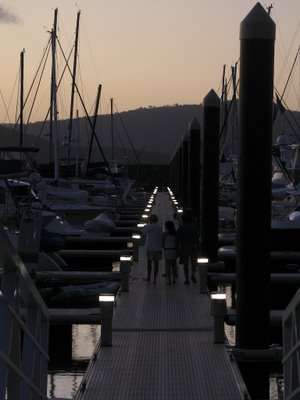Thursday, May 27, 2010
Sunday, October 01, 2006
Whitsundays: The Trip [Overview]
Every once in a while you experience something that lives up to the cliche 'once in a lifetime'. This past week I had several. I spent my mid-semester break at the Whitsunday Coast in northern Australia. The Whitsundays, a series of islands with pristine sand beaches, are a prime gateway to the Great Barrier Reef. After asking for vacation advice from every Aussie I knew I settled on the Whitsunday Coast; not a single person who had been there had anything but rave reviews. After a similar search, my Norwegian friend Milosz decided he would join me. Despite very high expectation, we were not disappointed.

Boats anchored along Arlie Beach.
In this entry I document my trip in great detail. Likely only my girlfriend, and my family will find this of much interest. If you get bored, just skip ahead to the next several entries which center on the photos I took.

A palm tree at Abel Point Marina.
Many years ago my friend's grandfather was host to a Rotary Exchange student. Two friends of this exchange student, Jonkie and Suzette are now married and live at the Whitsunday Coast with their daughter Morgan. To clarify, this is my friend's grandfather's former Rotary exchange student's friend's family. Yet, this family took me in; they picked me up at the airport, lodged and fed me, and gave me rides around town. I had naught but wine and thanks to give them, but I hope that one-day I can play host to their daughter, or daughter's friend, or daughter's friend's uncle's former roommate. Though that will probably have to wait until I live somewhere more interesting than Ohio.
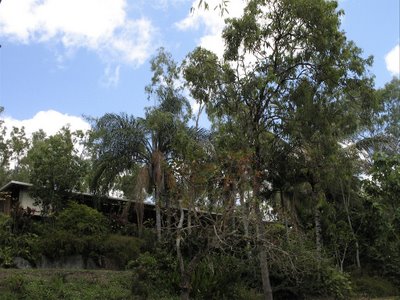
The beautiful home of Jonkie and Suzette where I stayed.
The day after we arrived, Milosz and I began our Scuba Diving lessons. To scuba without an instructor you have to go to Scuba School, complete with quizzes and exams. Following a suggestion from out hosts, Milosz and I enrolled in a 5-daOceaniase at Ocenia Dive, which went out of business the day we finished our lessons. The first two days were mostly paper work (being of good body and mind I sell my soul to...), videos (welcome to the exciting world of Scuba!), and basic pool exercises. We learned to float, sink, or hover. We practiced breathing using our buddies alternate air source and flooding/clearing our masks. We coughed and gagged but eventually overcame the mental block of breathing underwater. Most of all we had drilled into us the four most important principals of scuba diving: never hold your breath, ascend slowly, know how much air you have, and always look cool.
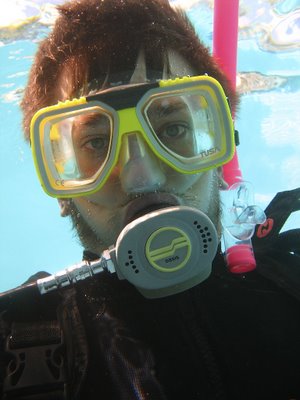
Self portrait in the pool the first day of scuba school.
After two days of classroom/pool learning we got on Oceania Dive boat with 25 other scuba divers, several dive instructors, and a small crew and took off for a three-day cruise of the Great Barrier Reef. Our initial excitement was tempered a bit by an hour-long boat-safety speech. Worse, the whole first night the boat was full-ahead towards our first dive site, making sleep very difficult. We had rather boring dives at 9am and 11am the first morning, mainly repeating what we had already done in the pool. What made these dives so boring is that we spent most of the dive in and around banks of sand, so that if we dropped too far we wouldn't cut ourselves on the reef, nor break off a chunk of reef that only grows a few millimeters a year. Finally, by the second day we started diving at sites that gave the name 'Great' Barrier Reef some meaning.

The Ocenia, as seen after surfacing from a dive.
Each dive went something like this. I would assemble my gear and check it over. Then, as a buddy-pair, Milosz and I would go through a safety check to make sure our buoyancy vests inflated, our primary and alternate air sources were okay, and our weight belts were secure. From this point on Milosz and I were a buddy pair and did everything together. We would either take a 'big step' off the boat or load into a small dingy, driven to a site up-current of the boat, sit on the edge of the dingy, and fall backwards into the water. We would deflate our vests and sink slowly to the bottom. As you sink the pressure in your nasal cavity increases, much like on a plane. Equalizing the pressure is done by the hold-nose-and-blow method or by swallowing. Some of the first time divers had problems equalizing this pressure and took a long time to descend. Fortunately both Milosz and I equalized easily. At the bottom we inflated our buoyancy vests a bit so that we would float with a full breath and sink with an exhale. Then we were free to swim around until our tanks reached 70 psi at which point we had to start ascending. At depth your blood absorbs a lot of nitrogen gas, and if you ascend slowly enough the nitrogen exits your body without consequence. However, if you ascend to fast this nitrogen explodes out of your body and causes everything form dizziness to brain damage and death. This is called the 'bends', and it's much easier to get than I would have thought. If you inflated your buoyancy vest at 18 meters, you're likely to surface dead. On our gear was a very conservative indicator that told you when you were ascending too quickly. Once back on the surface we would give the boat an 'OK' signal and then either swim back to the boat or signal for a pickup. On the boat we would record all the statistics of our dive.

My dive buddy, Milosz, practices staying above the reef during our first dive.
It was in the second and third day that I really started to enjoy scuba diving. I was able to control my buoyancy and sink/float/hover without much thought and became accustomed to swimming with as little exertion (and therefore as little air) as possible. Milosz and I earned our certification and were able to scuba as buddies, without an instructor or group. Swimming by our selves we saw more animal life and went to some very cool places. The whole cruise went off without a hitch. I was excited for every dive and after every dive found the sea had satisfied me. There are more details about exactly what I saw in the next blog entry. After returning from the trip the whole group met up at a local bar and the crew, many of whom had been out for 13 days in a row, led us all in a good spout of drinking.

Me performing a bit of kung-fu underwater. Photo by Milosz.
Back on land again, Milosz headed North to meet up with some friends, and I made plans for my last three days at the Whitsunday Coast. The first day I spent recuperating from scuba diving; I finished A Brave New World and wrote letters to Anita. The second day I did a rainforest walk, which was interesting, but mainly because it was so similar to a regular forest. Nevertheless there are a few interesting pictures in the next blog entry. The last day I went to three travel agencies before finding a scenic flight that wasn't booked. I'm glad I waited until the last minute to look for scenic flights because I ended up with a scruffy Aussie whose specialty was acrobatics and piloted a vintage bi-plane. He secured me in a buckle with no less than 5 straps coming out of it, and flew me around the islands at 1000 feet. It was a very clear day and we got great views of Whitehaven beach and Hamilton Island along with many other islands. Whitehaven is The Beach of Australia and is supposed to have the purest sand in the world, relating in some way to underwater volcanic activity and ocean currents. In any case it was simply stunning. Hamilton Island is the Newport of the Whitsunday Coast, complete with its own airport; all the rich and famous have resorts there. At the end of the circuit the pilot asked if I wanted to do some acrobatics, even though I hadn't paid for the acrobatic flight. A few barrel rolls later and I couldn't tell which blue was the ocean and which blue was the sky. Here's a short video during those acrobatics.
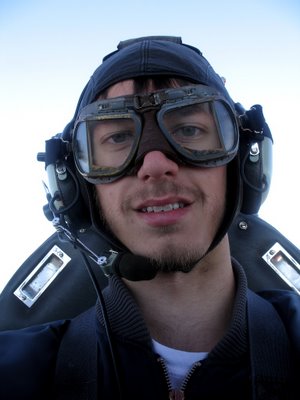
Self-portrait at 1000 feet, aboard the bi-plane in which I toured the Whitsundays.
Thoroughly disoriented and exhausted from spending 250 minutes underwater, 4 minutes flipping and dipping in the air, climbing rocks in a rainforest, and several bottles of wine, I headed home on a no-frills domestic airline. The airport was so small that the gate was actually that, a big gate in a fence-surrounded courtyard that you were herded into after getting through security. After lugging myself, my camera gear, and week's worth of smelly clothes through the city, on a bus, through the airport, plane, train, and up the hill to my home I thought to myself: I need a vacation!

Boats anchored along Arlie Beach.
In this entry I document my trip in great detail. Likely only my girlfriend, and my family will find this of much interest. If you get bored, just skip ahead to the next several entries which center on the photos I took.

A palm tree at Abel Point Marina.
Many years ago my friend's grandfather was host to a Rotary Exchange student. Two friends of this exchange student, Jonkie and Suzette are now married and live at the Whitsunday Coast with their daughter Morgan. To clarify, this is my friend's grandfather's former Rotary exchange student's friend's family. Yet, this family took me in; they picked me up at the airport, lodged and fed me, and gave me rides around town. I had naught but wine and thanks to give them, but I hope that one-day I can play host to their daughter, or daughter's friend, or daughter's friend's uncle's former roommate. Though that will probably have to wait until I live somewhere more interesting than Ohio.

The beautiful home of Jonkie and Suzette where I stayed.
The day after we arrived, Milosz and I began our Scuba Diving lessons. To scuba without an instructor you have to go to Scuba School, complete with quizzes and exams. Following a suggestion from out hosts, Milosz and I enrolled in a 5-daOceaniase at Ocenia Dive, which went out of business the day we finished our lessons. The first two days were mostly paper work (being of good body and mind I sell my soul to...), videos (welcome to the exciting world of Scuba!), and basic pool exercises. We learned to float, sink, or hover. We practiced breathing using our buddies alternate air source and flooding/clearing our masks. We coughed and gagged but eventually overcame the mental block of breathing underwater. Most of all we had drilled into us the four most important principals of scuba diving: never hold your breath, ascend slowly, know how much air you have, and always look cool.

Self portrait in the pool the first day of scuba school.
After two days of classroom/pool learning we got on Oceania Dive boat with 25 other scuba divers, several dive instructors, and a small crew and took off for a three-day cruise of the Great Barrier Reef. Our initial excitement was tempered a bit by an hour-long boat-safety speech. Worse, the whole first night the boat was full-ahead towards our first dive site, making sleep very difficult. We had rather boring dives at 9am and 11am the first morning, mainly repeating what we had already done in the pool. What made these dives so boring is that we spent most of the dive in and around banks of sand, so that if we dropped too far we wouldn't cut ourselves on the reef, nor break off a chunk of reef that only grows a few millimeters a year. Finally, by the second day we started diving at sites that gave the name 'Great' Barrier Reef some meaning.

The Ocenia, as seen after surfacing from a dive.
Each dive went something like this. I would assemble my gear and check it over. Then, as a buddy-pair, Milosz and I would go through a safety check to make sure our buoyancy vests inflated, our primary and alternate air sources were okay, and our weight belts were secure. From this point on Milosz and I were a buddy pair and did everything together. We would either take a 'big step' off the boat or load into a small dingy, driven to a site up-current of the boat, sit on the edge of the dingy, and fall backwards into the water. We would deflate our vests and sink slowly to the bottom. As you sink the pressure in your nasal cavity increases, much like on a plane. Equalizing the pressure is done by the hold-nose-and-blow method or by swallowing. Some of the first time divers had problems equalizing this pressure and took a long time to descend. Fortunately both Milosz and I equalized easily. At the bottom we inflated our buoyancy vests a bit so that we would float with a full breath and sink with an exhale. Then we were free to swim around until our tanks reached 70 psi at which point we had to start ascending. At depth your blood absorbs a lot of nitrogen gas, and if you ascend slowly enough the nitrogen exits your body without consequence. However, if you ascend to fast this nitrogen explodes out of your body and causes everything form dizziness to brain damage and death. This is called the 'bends', and it's much easier to get than I would have thought. If you inflated your buoyancy vest at 18 meters, you're likely to surface dead. On our gear was a very conservative indicator that told you when you were ascending too quickly. Once back on the surface we would give the boat an 'OK' signal and then either swim back to the boat or signal for a pickup. On the boat we would record all the statistics of our dive.

My dive buddy, Milosz, practices staying above the reef during our first dive.
It was in the second and third day that I really started to enjoy scuba diving. I was able to control my buoyancy and sink/float/hover without much thought and became accustomed to swimming with as little exertion (and therefore as little air) as possible. Milosz and I earned our certification and were able to scuba as buddies, without an instructor or group. Swimming by our selves we saw more animal life and went to some very cool places. The whole cruise went off without a hitch. I was excited for every dive and after every dive found the sea had satisfied me. There are more details about exactly what I saw in the next blog entry. After returning from the trip the whole group met up at a local bar and the crew, many of whom had been out for 13 days in a row, led us all in a good spout of drinking.

Me performing a bit of kung-fu underwater. Photo by Milosz.
Back on land again, Milosz headed North to meet up with some friends, and I made plans for my last three days at the Whitsunday Coast. The first day I spent recuperating from scuba diving; I finished A Brave New World and wrote letters to Anita. The second day I did a rainforest walk, which was interesting, but mainly because it was so similar to a regular forest. Nevertheless there are a few interesting pictures in the next blog entry. The last day I went to three travel agencies before finding a scenic flight that wasn't booked. I'm glad I waited until the last minute to look for scenic flights because I ended up with a scruffy Aussie whose specialty was acrobatics and piloted a vintage bi-plane. He secured me in a buckle with no less than 5 straps coming out of it, and flew me around the islands at 1000 feet. It was a very clear day and we got great views of Whitehaven beach and Hamilton Island along with many other islands. Whitehaven is The Beach of Australia and is supposed to have the purest sand in the world, relating in some way to underwater volcanic activity and ocean currents. In any case it was simply stunning. Hamilton Island is the Newport of the Whitsunday Coast, complete with its own airport; all the rich and famous have resorts there. At the end of the circuit the pilot asked if I wanted to do some acrobatics, even though I hadn't paid for the acrobatic flight. A few barrel rolls later and I couldn't tell which blue was the ocean and which blue was the sky. Here's a short video during those acrobatics.

Self-portrait at 1000 feet, aboard the bi-plane in which I toured the Whitsundays.
Thoroughly disoriented and exhausted from spending 250 minutes underwater, 4 minutes flipping and dipping in the air, climbing rocks in a rainforest, and several bottles of wine, I headed home on a no-frills domestic airline. The airport was so small that the gate was actually that, a big gate in a fence-surrounded courtyard that you were herded into after getting through security. After lugging myself, my camera gear, and week's worth of smelly clothes through the city, on a bus, through the airport, plane, train, and up the hill to my home I thought to myself: I need a vacation!
Whitsundays: Infrared Landscapes
These are a few infrared images I took while at the Whitsunday Coast.
Infrared photography relies on light outside the visible spectrum. Just as a red flower is red because it strongly reflects red light, an object is brighter (or darker) in infrared photography based on how much infrared light it reflects. Foliage containing chlorophyll, which strongly reflects infrared light, is bright, while open sky, which reflects blue light but very little infrared light, is very dark. This creates an interesting reversal of tones; instead of a light sky and dark foliage, the sky is very dark and foliage glows brightly. Photographers can take advantage of this tone reversal to create an eerie or ethereal feeling.
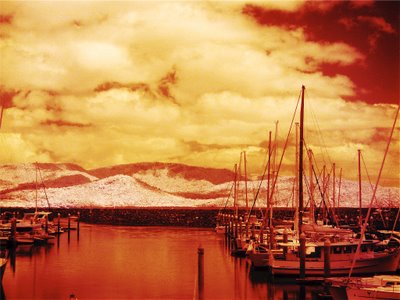



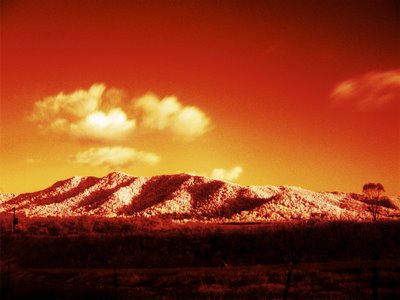
Infrared photography relies on light outside the visible spectrum. Just as a red flower is red because it strongly reflects red light, an object is brighter (or darker) in infrared photography based on how much infrared light it reflects. Foliage containing chlorophyll, which strongly reflects infrared light, is bright, while open sky, which reflects blue light but very little infrared light, is very dark. This creates an interesting reversal of tones; instead of a light sky and dark foliage, the sky is very dark and foliage glows brightly. Photographers can take advantage of this tone reversal to create an eerie or ethereal feeling.





Saturday, September 30, 2006
Whitsundays: Underwater Animals
When you watch documentaries about the Great Barrier Reef there are fish everywhere. Schools of fish crash together and brightly colored fish hide behind every corner. It was perhaps my greatest surprise that the Great Barrier Reef was exactly like in documentaries.
Here is just a sampling of the fish that stayed still long enough for me to photograph.




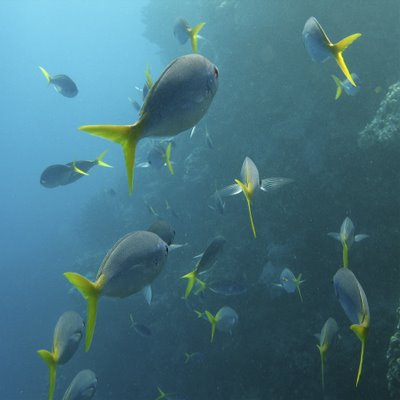




Here is just a sampling of the fish that stayed still long enough for me to photograph.









Whitsundays: Underwater Landscapes
The ocean floor is full of valleys and hills that form some wonderful landscapes. Schools of fish often cling to the side of these valleys and hills. Adding an extra level of interest. Best of all, the landscapes don't move, which is a relief after chasing shy fish.

Though not an underwater landscape, this image didn't fit in any of the other catagories. This is a combination of several exposures taken on the boat about 10 minutes after sunset.

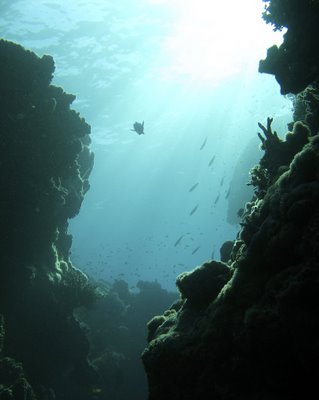
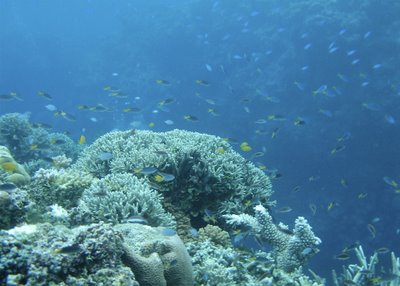

Though not an underwater landscape, this image didn't fit in any of the other catagories. This is a combination of several exposures taken on the boat about 10 minutes after sunset.



Whitsundays: Scenic Flight
The last day of my vacation I was determined to take a scenic flight of the Whitsunday Coast. The only aviator who had a slot free was an old gruffy Aussie who did acrobatic stunts in a bi-plane. I opted for the scenic flight, but at the end he threw in a few flips and rolls for fun.
In between loud obscenities and gasping for air I was able to shoot a short clip of the acrobatics. During the more relaxing half of the flight I shot these stills.



The Whitehaven Beach (above and below) which is supposedly has the purest sand of any beach in the world. Looks like a man and a horse to me.

In between loud obscenities and gasping for air I was able to shoot a short clip of the acrobatics. During the more relaxing half of the flight I shot these stills.



The Whitehaven Beach (above and below) which is supposedly has the purest sand of any beach in the world. Looks like a man and a horse to me.

Tuesday, September 19, 2006
Water Drops for Santos Energy
Several months ago I ran across a nerd-toy called the Time Machine. It is an external dedicated intervalometer and sensory input triggering device. In other words, it is a box which plugs into a camera and triggers a picture to be taken at set intervals and/or when a sensor (e.g. laser, motion, noise) is triggered. Seeing some of the possibilities on the Time Machine website my interest was immediately piqued. Then several weeks ago I ran across the work of Martin Waugh who uses a similar system to take pictures of splashes from water drops.
I loved the images so much that I bought a Time Machine and made my own water-drip setup. That attempt failed miserably, mainly because I tried to setup a water drip reservoir, so that drops would fall at regular intervals without intervention. For my second attempt I replaced the reservoir with a water dropper and got some decent results. Finally, I was able to setup a water dropper system that was sufficiently repeatable that I could focus on lighting and image design.
When using a water dropper to produce a single drop, water splashes are only a few millimeters across. This size creates two problems. First you need a macro lens that can focus REALLY close. Second, with a macro lens focused that closely the depth of field is often less than the width of a splash, which means precise focusing is critical. After all the effort required to perfect a water drip I wanted to make sure to capture the result in the highest practical quality. Therefore I used my Mamiya 645 Manual Focus camera with one of my favorite lenses, the Mamiya 120mm Macro. If you are so inclined, you can experiment with the numbers using an online depth of field calculator.
As it happened, just as I was perfecting the water-drop technique, my university received an invitation to submit images to a corporate client. The client had blue/white corporate colors and wanted generic images that showed energy and fit with the feel of their current website. Water drops seemed to fit the image request quite well. Shown below are the images I submitted to the client, which they accepted for a hefty sum. The return from this investment will cover the cost of a scuba diving trip around the Great Barrier Reef that I will be going on this coming week.
UPDATE: My submission to Santo Corporation was used on the front page of the annual Sustainability Report (an addendum to the financially-focused Annual Report). I was particularly pleased that they repeated the predominate color of the image throughout the report.
Use of my photos:
As a professional photographer my photographs are my life's work.
In this case Santos Energy bought the rights to these images by paid contract, and are used here under the Portfolio Use terms of that contract. The images may not be reproduced in any form. Leave a comment if you wish to discuss the creation of similar images.



I loved the images so much that I bought a Time Machine and made my own water-drip setup. That attempt failed miserably, mainly because I tried to setup a water drip reservoir, so that drops would fall at regular intervals without intervention. For my second attempt I replaced the reservoir with a water dropper and got some decent results. Finally, I was able to setup a water dropper system that was sufficiently repeatable that I could focus on lighting and image design.
When using a water dropper to produce a single drop, water splashes are only a few millimeters across. This size creates two problems. First you need a macro lens that can focus REALLY close. Second, with a macro lens focused that closely the depth of field is often less than the width of a splash, which means precise focusing is critical. After all the effort required to perfect a water drip I wanted to make sure to capture the result in the highest practical quality. Therefore I used my Mamiya 645 Manual Focus camera with one of my favorite lenses, the Mamiya 120mm Macro. If you are so inclined, you can experiment with the numbers using an online depth of field calculator.
As it happened, just as I was perfecting the water-drop technique, my university received an invitation to submit images to a corporate client. The client had blue/white corporate colors and wanted generic images that showed energy and fit with the feel of their current website. Water drops seemed to fit the image request quite well. Shown below are the images I submitted to the client, which they accepted for a hefty sum. The return from this investment will cover the cost of a scuba diving trip around the Great Barrier Reef that I will be going on this coming week.
UPDATE: My submission to Santo Corporation was used on the front page of the annual Sustainability Report (an addendum to the financially-focused Annual Report). I was particularly pleased that they repeated the predominate color of the image throughout the report.
Use of my photos:
As a professional photographer my photographs are my life's work.
In this case Santos Energy bought the rights to these images by paid contract, and are used here under the Portfolio Use terms of that contract. The images may not be reproduced in any form. Leave a comment if you wish to discuss the creation of similar images.



Nude Landscapes and Nude Abstracts
The less Puritan view of nudity in Australia (compared to the United States) allowed me to complete two fine-art-nude shoots. Creating compelling images using nothing but the human body and lighting is challenging. Any sexuality or awkwardness is obscured by the constant struggle to find interesting lines, shapes, and textures.
In both of these shoots I used two cameras. The first was a point and shoot digital camera which I used mainly to evaluate lighting and composition. The second was an 8"x10" film view camera. Being 8x10 this film has 80 sq. inches, a full 60 times more than 35mm. The resulting image is around 400-600 megapixels. This quality is why digital cameras won't displace film in applications requiring top-quality for quite some time. In fact, a group of photo nerds has modified an air force aerial camera to produce 1000+ megapixel images.
These models have given permission to have the images used in this blog. Please respect their privacy by not reproducing these images without my explicit permission.
Please Note:
!ARTISTIC NUDE IMAGES SHOWN BELOW!




In both of these shoots I used two cameras. The first was a point and shoot digital camera which I used mainly to evaluate lighting and composition. The second was an 8"x10" film view camera. Being 8x10 this film has 80 sq. inches, a full 60 times more than 35mm. The resulting image is around 400-600 megapixels. This quality is why digital cameras won't displace film in applications requiring top-quality for quite some time. In fact, a group of photo nerds has modified an air force aerial camera to produce 1000+ megapixel images.
These models have given permission to have the images used in this blog. Please respect their privacy by not reproducing these images without my explicit permission.
Please Note:
!ARTISTIC NUDE IMAGES SHOWN BELOW!
















